On the Mechanics of Immediate Corrections and Aftereffects in Prism Adaptation
Abstract
:1. Introduction
2. Results
2.1. Experiment 1: Pointing and Throwing
2.2. Experiment 2: Central versus Rotated Chair in the Dark
2.2.1. Direct Effect: Central versus Rotated Chair Position
2.2.2. Aftereffect: Central versus Rotated Chair Position
2.2.3. Adaptive Components: Central versus Rotated Chair Position
2.3. Experiment 3: Light versus Dark Conditions
2.3.1. Direct Effect
2.3.2. Aftereffect
3. Discussion
3.1. Test of First Hypothesis: No Head Rotation in the Dark
3.2. Test of Second Hypothesis: Unconscious Body Rotations Correspond Quantitatively to the Immediate Correction Effect
4. Materials and Methods
4.1. Ethics Statement
4.2. Participants and General Procedure
4.3. Experiment 1: Pointing and Throwing
4.3.1. Experimental Set-Up for Pointing
4.3.2. Procedure for Pointing
4.3.3. Experimental Set-Up & Procedure for Throwing
4.4. Set-Up & Procedure for Experiment 2: Central versus Rotated Chair in the Dark
4.4.1. Experimental Set-Up
4.4.2. Procedure
4.5. Set-Up & Procedure for Experiment 3: Light versus Dark Conditions
Experimental Set-Up and Procedure
4.6. Analysis
Data Analysis Pointing
5. Conclusions
Supplementary Materials
Acknowledgments
Author Contributions
Conflicts of Interest
References
- Baraduc, P.; Wolpert, D.M. Adaptation to a visuomotor shift depends on the starting posture. J. Neurophysiol. 2002, 88, 973–981. [Google Scholar] [PubMed]
- Crawford, J.D.; Medendorp, W.P.; Marotta, J.J. Spatial transformations for eye-hand coordination. J. Neurophysiol. 2004, 92, 10–19. [Google Scholar] [CrossRef] [PubMed]
- Guan, J.; Wade, M.G. The effect of aging on adaptive eye-hand coordination. J. Gerontol. Ser. B Psychol. Sci. Soc. Sci. 2000, 55, 151–162. [Google Scholar] [CrossRef]
- Hatada, Y.; Rossetti, Y.; Miall, R.C. Long-lasting aftereffect of a single prism adaptation: Shifts in vision and proprioception are independent. Exp. Brain Res. 2006, 173, 415–424. [Google Scholar] [CrossRef] [PubMed]
- Redding, G.M.; Wallace, B. Prism adaptation during target pointing from visible and nonvisible starting locations. J. Motor Behav. 1997, 29, 119–130. [Google Scholar] [CrossRef] [PubMed]
- Rossetti, Y.; Koga, K.; Mano, T. Prismatic displacement of vision induces transient changes in the timing of eye-hand coordination. Percept. Psychophys. 1993, 54, 355–364. [Google Scholar] [CrossRef] [PubMed]
- Taub, E.; Goldberg, I.A. Prism adaptation: Control of intermanual transfer by distribution of practice. Science 1973, 180, 755–757. [Google Scholar] [CrossRef] [PubMed]
- Redding, G.M.; Wallace, B. Generalization of prism adaptation. J. Exp. Psychol. Hum. Percept. Perform. 2006, 32, 1006–1022. [Google Scholar] [CrossRef] [PubMed]
- Bornschlegl, M.A.; Fahle, M.; Redding, G.M. The role of movement synchronization with an auditory signal in producing prism adaptation. Perception 2012, 41, 950–962. [Google Scholar] [CrossRef] [PubMed]
- Efstathiou, E. Effects of exposure time and magnitude of prism transform on eye-hand coordination. J. Exp. Psychol. 1969, 81, 235–240. [Google Scholar] [CrossRef] [PubMed]
- Hay, J.C.; Pick, H.L., Jr. Visual and proprioceptive adaptation to optical displacement of the visual stimulus. J. Exp. Psychol. 1966, 71, 150–158. [Google Scholar] [CrossRef] [PubMed]
- Redding, G.M.; Wallace, B. Effects on prism adaptation of duration and timing of visual feedback during pointing. J. Motor Behav. 1990, 22, 209–224. [Google Scholar] [CrossRef]
- Redding, G.M.; Wallace, B. Adaptive coordination and alignment of eye and hand. J. Motor Behav. 1993, 25, 75–88. [Google Scholar] [CrossRef] [PubMed]
- Redding, G.M.; Rossetti, Y.; Wallace, B. Applications of prism adaptation: A tutorial in theory and method. Neurosci. Biobehav. Rev. 2005, 29, 431–444. [Google Scholar] [CrossRef] [PubMed]
- Melamed, L.E.; Beckett, P.A.; Wallace, B. The effect of prism strength and response mode on the magnitude of the correction effect in prism viewing. Percept. Psychophys. 1978, 23, 176–180. [Google Scholar] [CrossRef] [PubMed]
- Redding, G.M.; Wallace, B. First-trial adaptation to prism exposure. J. Motor Behav. 2003, 35, 229–245. [Google Scholar] [CrossRef] [PubMed]
- Redding, G.M.; Wallace, B. First-trial “adaptation” to prism exposure: Artifact of visual capture. J. Motor Behav. 2004, 36, 291–304. [Google Scholar] [CrossRef] [PubMed]
- Pochopien, K.; Fahle, M. How to get the full prism effect. i-Perception 2015, 6, 1–10. [Google Scholar] [CrossRef] [PubMed]
- Harris, C.S. Adaptation to displaced vision: Visual, motor, or proprioceptive change? Science 1963, 140, 812–813. [Google Scholar] [CrossRef] [PubMed]
- Harris, C.S. Perceptual adaptation to inverted 1963 reversed and displaced vision. Psychol. Rev. 1965, 72, 419–444. [Google Scholar] [CrossRef] [PubMed]
- Redding, G.M.; Wallace, B. Intermanual transfer of prism adaptation. J. Motor Behav. 2008, 40, 246–262. [Google Scholar] [CrossRef] [PubMed]
- Redding, G.M.; Wallace, B. Asymmetric visual prism adaptation and intermanual transfer. J. Motor Behav. 2009, 41, 83–94. [Google Scholar] [CrossRef] [PubMed]
- Rock, I.; Goldberg, J.; Mack, A. Immediate correction and adaptation based on viewing a prismatically displaced scene. Percept. Psychophys. 1966, 1, 351–354. [Google Scholar] [CrossRef]
- Bach, M. The freiburg visual acuity test-automatic measurement of visual acuity. Optom. Vis. Sci. 1996, 73, 49–53. [Google Scholar] [CrossRef] [PubMed]
- Lang, J. Ein neuer Stereotest. Klin. Monbl. Augenheilkd. 1983, 182, 373–375. [Google Scholar] [CrossRef]
- Redding, G.M.; Clark, S.E.; Wallace, B. Attention and prism adaptation. Cogn. Psychol. 1985, 17, 1–25. [Google Scholar] [CrossRef]
- Haarmeier, T.; Thier, P. Modification of the filehne illusion by conditioning visual stimuli. Vis. Res. 1996, 36, 741–750. [Google Scholar] [CrossRef]
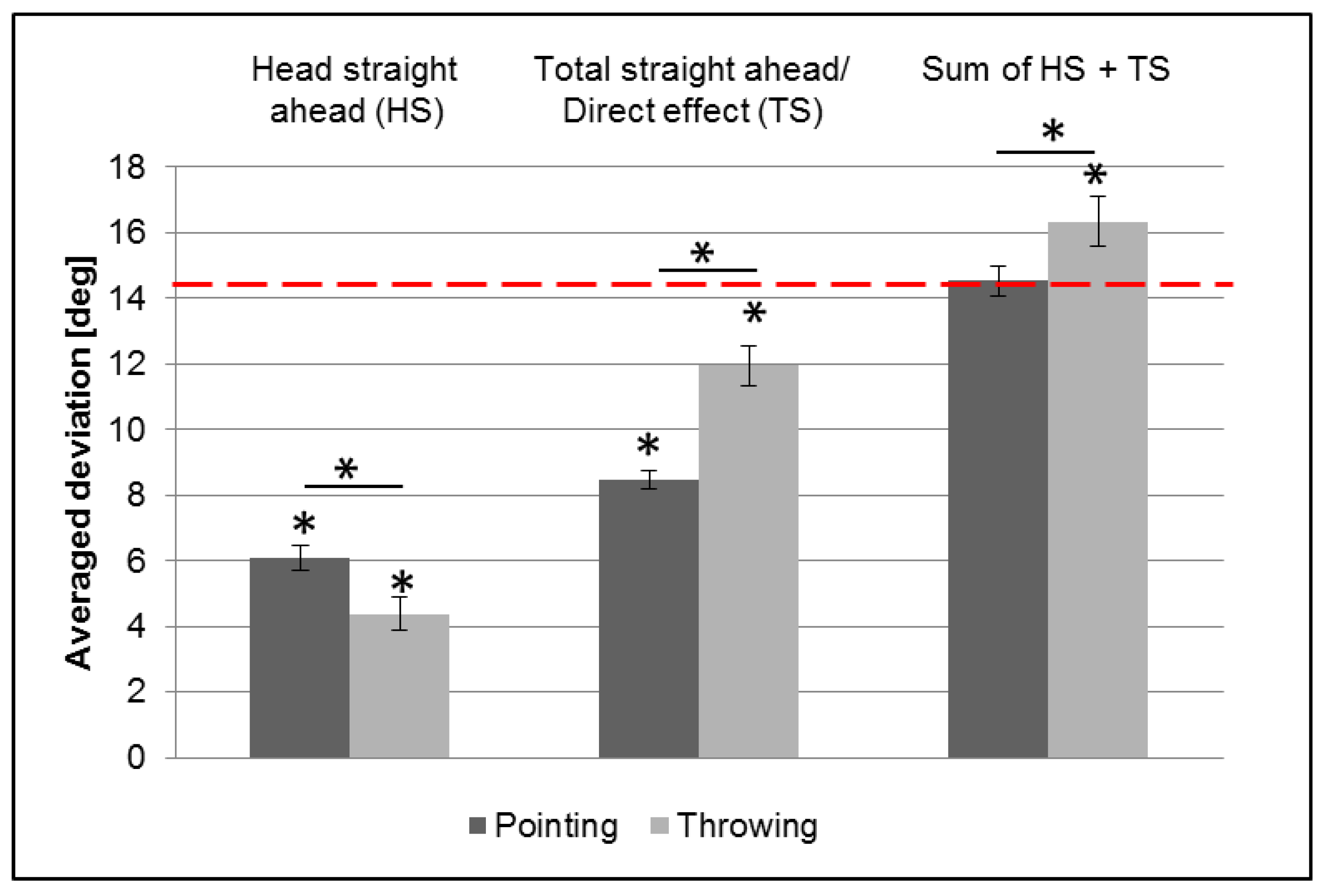
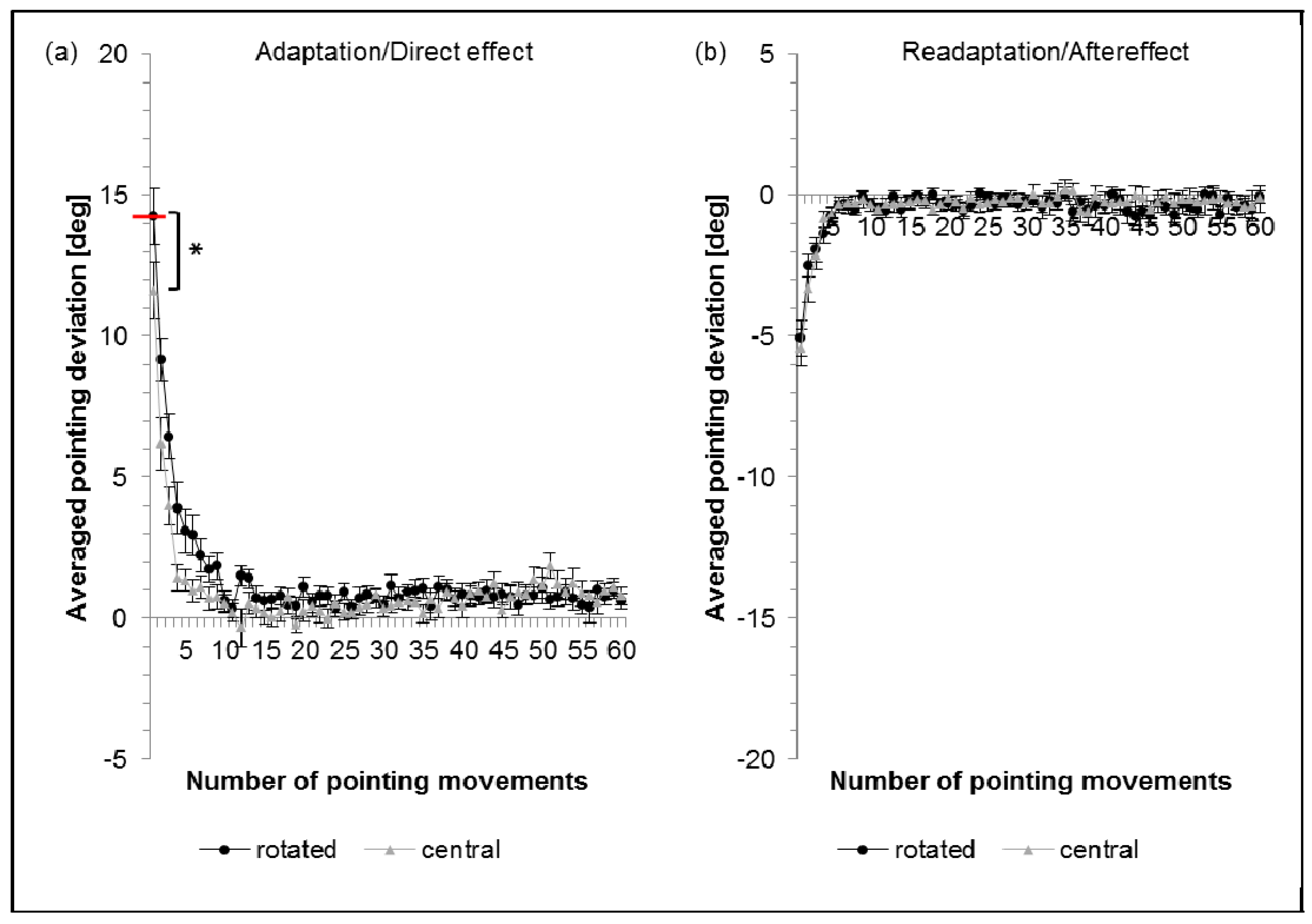
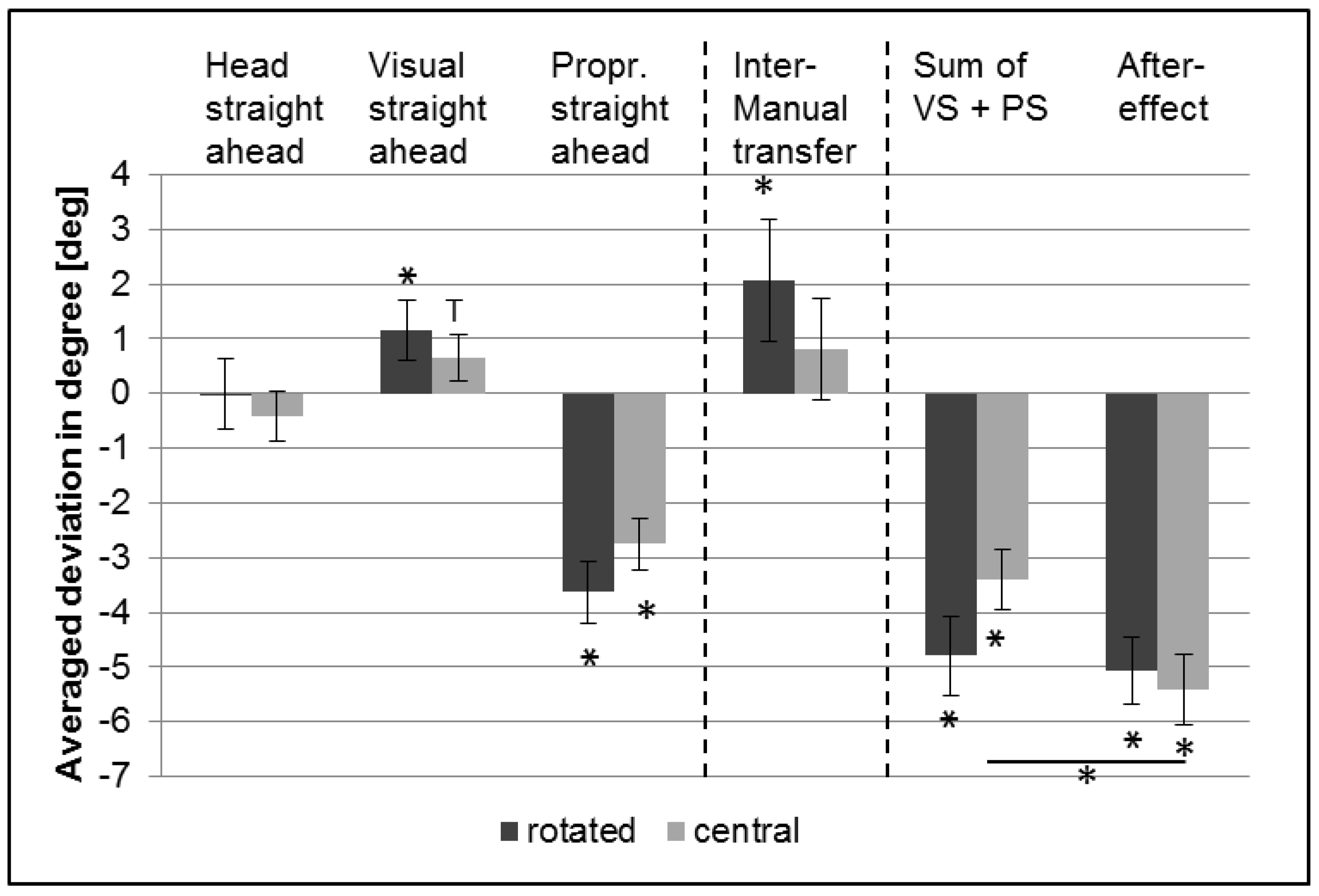
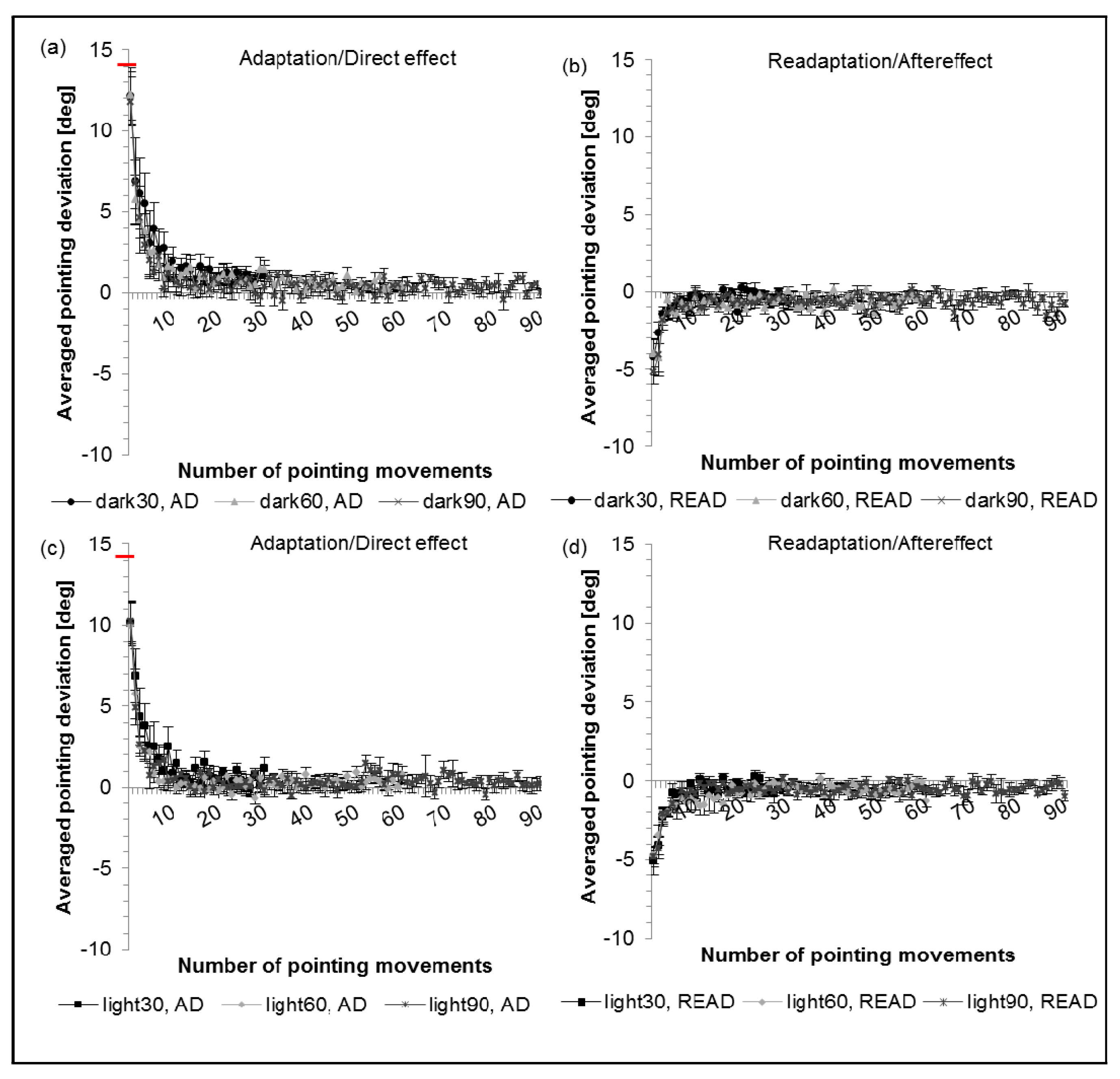


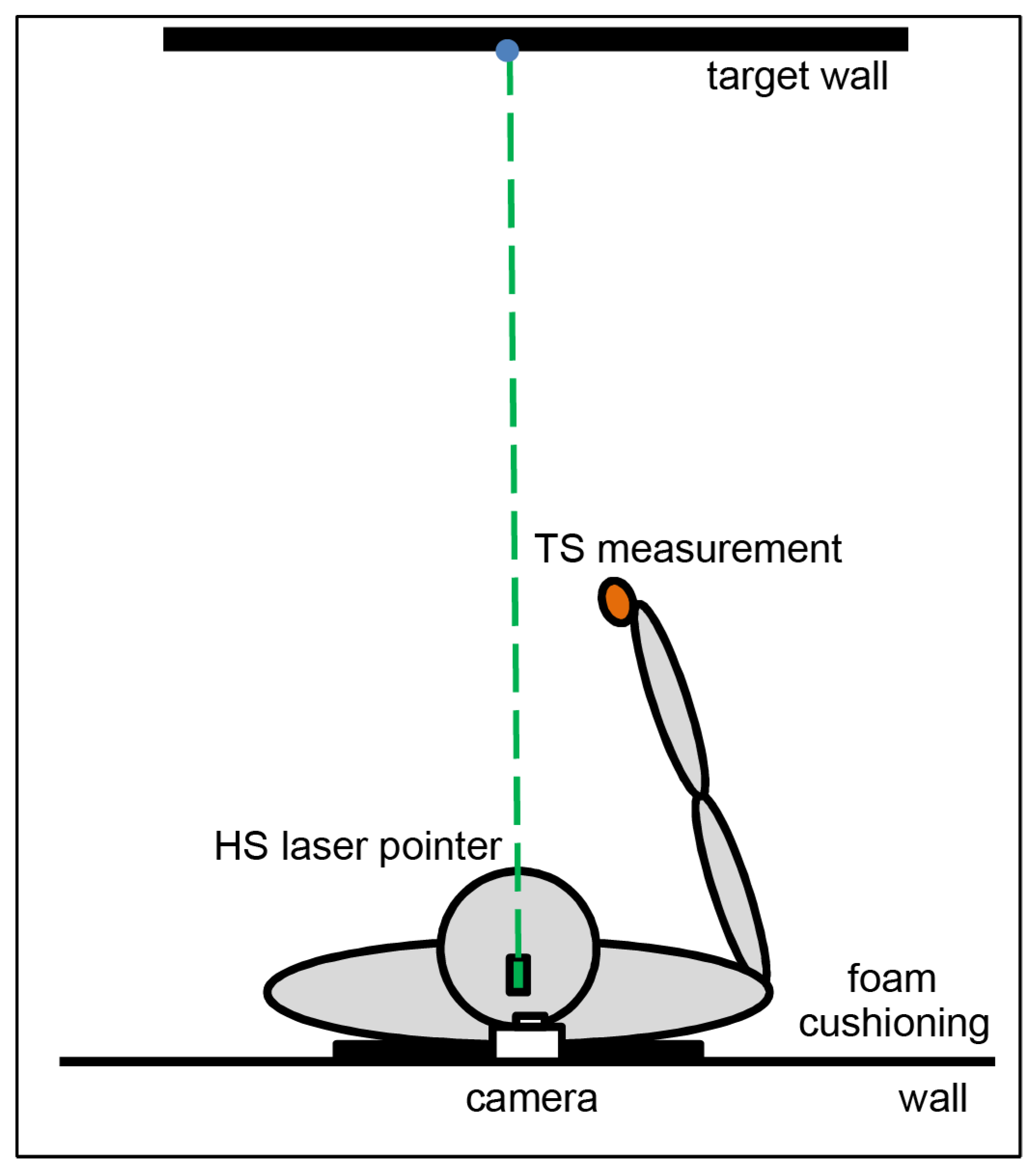

| Condition | Mean (°) | SE (°) | t-Value | p-Value |
|---|---|---|---|---|
| HS + TS, pointing | 14.54 | 0.46 | 0.52 | 0.604 |
| HS + TS, throwing | 16.33 | 0.76 | 2.66 | 0.012 * |
| Condition | Direct Effect (%) | SE (%) | t-Value | p-Value |
|---|---|---|---|---|
| DE, rotated | 100 | 7 | 0.06 | 0.478 |
| DE, central | 82 | 7 | −2.57 | 0.008 * |
| Conditions | Mean VS + PS (°) | SE VS + PS (°) | Mean AE (°) | SE AE (°) | t-Value | p-Value |
|---|---|---|---|---|---|---|
| dark, rotated | −4.80 | 0.71 | −5.07 | 0.62 | 0.32 | 0.752 |
| dark, central | −3.40 | 0.55 | −5.41 | 0.64 | 2.68 | 0.013* |
| Conditions | Direct Effect (%) | SE (%) | t-Value | p-Value |
|---|---|---|---|---|
| DE, dark 30 | 86 | 12 | −1.16 | 0.143 |
| DE, dark 60 | 86 | 11 | −1.33 | 0.114 |
| DE, dark 90 | 83 | 10 | −1.62 | 0.075 T |
| DE, light 30 | 71 | 9 | −3.16 | 0.008 * |
| DE, light 60 | 71 | 9 | −3.18 | 0.008 * |
| DE, light 90 | 72 | 9 | −3.26 | 0.007 * |
© 2017 by the authors. Licensee MDPI, Basel, Switzerland. This article is an open access article distributed under the terms and conditions of the Creative Commons Attribution (CC BY) license (http://creativecommons.org/licenses/by/4.0/).
Share and Cite
Pochopien, K.; Spang, K.; Stemmler, T.; Fahle, M. On the Mechanics of Immediate Corrections and Aftereffects in Prism Adaptation. Vision 2017, 1, 27. https://doi.org/10.3390/vision1040027
Pochopien K, Spang K, Stemmler T, Fahle M. On the Mechanics of Immediate Corrections and Aftereffects in Prism Adaptation. Vision. 2017; 1(4):27. https://doi.org/10.3390/vision1040027
Chicago/Turabian StylePochopien, Klaudia, Karoline Spang, Torsten Stemmler, and Manfred Fahle. 2017. "On the Mechanics of Immediate Corrections and Aftereffects in Prism Adaptation" Vision 1, no. 4: 27. https://doi.org/10.3390/vision1040027
APA StylePochopien, K., Spang, K., Stemmler, T., & Fahle, M. (2017). On the Mechanics of Immediate Corrections and Aftereffects in Prism Adaptation. Vision, 1(4), 27. https://doi.org/10.3390/vision1040027





